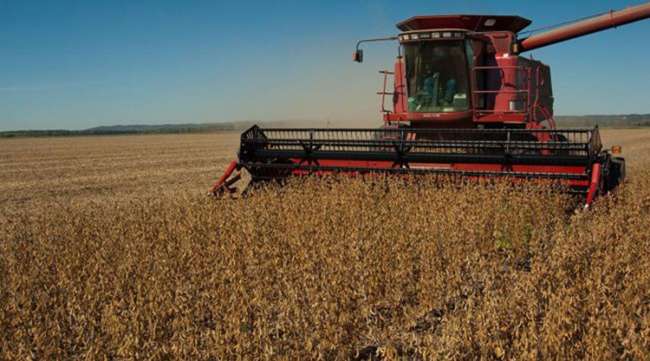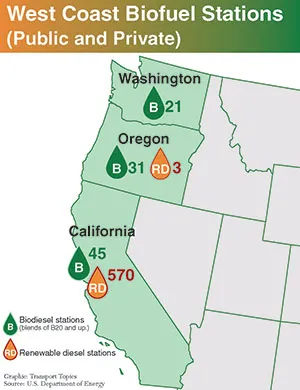Staff Reporter
West Coast Swapping Diesel for Biofuels

[Stay on top of transportation news: Get TTNews in your inbox.]
The West Coast’s growing demand for renewable diesel and biodiesel fuel will drive petroleum diesel usage there next year to the lowest level in more than a decade, according to the U.S. Energy Information Administration.
From January through April this year, diesel (categorized as distillate fuel oil) consumption in California, Washington and Oregon dropped to about 400,000 barrels per day. Distillate fuel oil is a refined petroleum product used as diesel fuel.
This year’s diesel usage so far is about 18% less than last year’s annual average and down from about 450,000 barrels per day in 2000.
“Last year, U.S. West Coast distillate [diesel] consumption, as measured by product supplied, was at its lowest since 2002 and is on track to fall further this year. The growing use of biofuels instead of petroleum diesel is the primary cause for the decline,” EIA, an arm of the U.S. Department of Energy, noted July 10.
Biofuels (biodiesel and renewable diesel) have become alternatives to diesel and are helping meet emission requirements set by California, Oregon and Washington. EIA pointed out, though, that in the rest of the country, diesel consumption has risen to pre-pandemic levels.

California, Oregon and Washington have a combined 670 biodiesel or renewable diesel fuel stations. (U.S. Department of Energy)
EIA stated that renewable diesel has a growing share of the West Coast’s diesel fuel market because clean-fuel programs are providing incentives for it as a fuel source. In fact, nearly all the renewable diesel produced in the United States is used in California.
Both renewable diesel and biodiesel can be used to replace diesel. Able to be used in diesel engines in any concentration, renewable diesel is chemically identical to petroleum-based diesel but made using fats, vegetable oils or greases. Similarly, biodiesel is made with the same feedstocks but blended with diesel and is chemically different.
EIA noted renewable diesel use has continued to outpace biodiesel since it first did in January 2022 because renewable diesel can be blended in any concentration and works better than biodiesel in cold temperatures. Renewable diesel can be transported in the same petroleum diesel pipelines. Also, petroleum refineries can be converted to make renewable diesel in larger plants.
The total number of public and private biofuel stations in the United States is 1,885, with biodiesel having the most at 1,312 and renewable biodiesel at 573, according to EIA. California has 570 renewable diesel stations and only 45 biodiesel ones. However, biodiesel stations outnumber renewable diesel stations in Washington, 21 to zero. Oregon has 31 biodiesel stations and only three for renewable biodiesel.

The makers of Transport Topics’ updated Top 100 For-Hire Carriers list examine trucking’s shifting business environment and what it means for the supply chain. Tune in above or by going to RoadSigns.ttnews.com.
While both biodiesel and renewable diesel fall within the U.S. Environmental Protection Agency’s Renewable Fuel Standard program that requires the nation’s transportation fuel to have renewable requirements, renewable diesel has an edge over biodiesel since it receives slightly more credits.
The West Coast’s increasing reliance on biofuel over diesel is no surprise to Paul Winters, public affairs and federal communications director at Clean Fuels Alliance America, which represents renewable organizations.
“The California and Oregon low-carbon fuel programs have been very successful in displacing petroleum with better, cleaner fuels. In California, renewable diesel and biodiesel now make up more than 45% of the state’s diesel fuel pool. And in Oregon, these fuels make up 14% of the diesel market. These states represent a considerable part of the nation’s diesel market, so it’s not surprising that there’s now a recognizable impact on market data,” Winters remarked.
He said EPA “failed to account for this growth and impact” in its June 21 finalized Renewable Fuel Standard rule for 2023, 2024 and 2025, which caused a massive outcry from biofuel interests (including agricultural states) for setting lower levels that conflict with current and future production levels as well as growth potential.
Want more news? Listen to today's daily briefing above or go here for more info
“The final biomass-based diesel volumes in the volumes simply don’t match the volumes available in the market,” Winters said. “It’s also apparent that EPA failed to understand the change in EIA reports, recategorizing refinery input adjustments as renewable product supplied. In the final rule, EPA decided to adjust EIA’s reported volumes of gasoline and diesel by 3.5%. This mechanism did not appear in the proposal — there was no opportunity for public comment. It’s possible that they would not have taken that step if they had consulted with EIA on this change in data reports.”
In fact, EIA on July 11 lowered its short-term energy outlook on U.S. renewable diesel production because of the impact of the EPA’s renewable fuel ruling last month.
EIA noted it reduced its forecast for renewable diesel production growth, but “we still expect renewable diesel production will grow in the United States to reach 219,000 barrels per day in 2024.” That output volume is 2.8% lower than an earlier estimate before the EPA’s ruling. U.S. renewable diesel production now stands at 161,000 barrels per day for this year.




